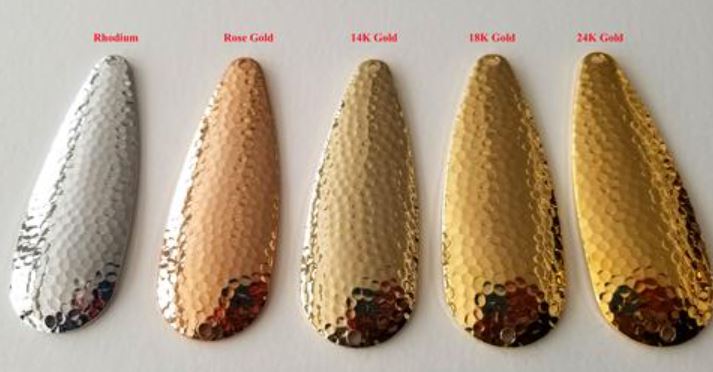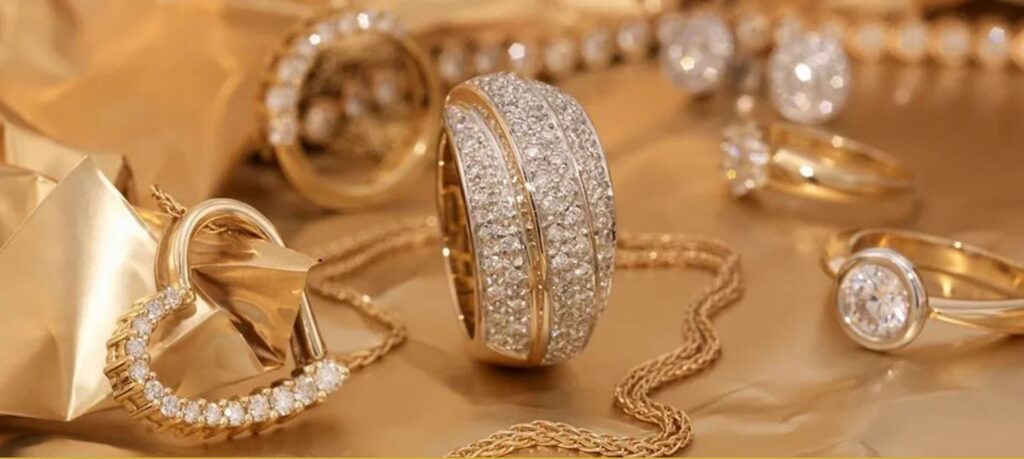Fashion of wearing gold plating jewelry has been on the rise in recent times. Multiple factors like affordability, shiny essence and beautiful aesthetics are often credited for this demand. This article will answer different questions related to gold plating like what is gold plating, its composition, process, types and how to care for gold filled and gold plated jewelry.
What is Gold Plating in Jewelry
Gold plating involves putting a microscopic layer of gold over a cheap base metal such as sterling silver through electrochemical process. The idea here is to give sterling silver the appearance and beauty of gold while staying affordable. Size of this thin gold layer can vary from jewelry to jewelry. Generally, it remains in between 0.5 microns to 5 microns. Apart from this, gold in different purity levels can also be electroplated to customize the appearance as per the customer demand.
Other metals used for god plating are brass, bronze, copper, 935 and 950 sterling silver. These metals are relatively cheaper and readily available in the market, so gold plating becomes a must option to have.
How Gold Plating is Done
Gold plating is done in an electrochemical tank containing ionic gold where two electric charged plates are used called as anode and cathode. The anode plate is the base metal on which gold is needed to be plated i.e. sterling silver. Once both plates are connected to the battery, opposite charges appear on to the plates where ionic gold as it is a positively charged metal, starts moving towards anode.
It gets neutralized at the anode resulting in sticking of gold atoms on the surface of sterling silver. The more you allow this reaction to proceed, thicker will the gold layer get.
Once electroplating is done, the finished product is rinsed, cleaned and polished to enhance its beauty.

Types of Gold Plating
Gold plating can be various types depending on layer thickness as well as gold purity levels. There are several methods of gold plating, each varying in thickness and durability. Thicker a coating is, more durable it will be.
Flash Plating
- Thickness: Less than 0.5 microns.
- Durability: Least durable, suitable for items that are not subjected to heavy wear.
Normal Gold Plating
- Thickness: Ranges from 0.5 to 2.5 microns or more.
- Durability: More durable and long-lasting compared to flash plating.
Vermeil
- Durability: High-quality and durable.
- Thickness: At least 2.5 microns of gold over sterling silver. Max can be 5 microns.
9k vs 14k Gold Plating
Gold plating comes in many variants as per their purity levels. As pure 24k gold is too soft for plating, it can’t be used anywhere. Some jewelry sellers might also use these 24k plated tags to trick their customer. Whenever you hear them, just leave.
Common purity levels available in the market are:
- 9k
- 10k
- 14k
- 18k
- 21k
- 23k
9k gold has the least purity levels among all. It consists of 9 parts gold out of 24 parts. Other portion is made up of either copper or nickel. 9k gold have the greatest hardness among all making it very suitable for gold plating. But on the same time, it loses its typical yellowish gold shine due to less amount of gold used.

As we move upward, purity level increases and hardness decreases. If you’re looking for an optimum balance between yellow gold appearance and hardness, 14k and 18k are the options to go.
Apart from this, gold can also be plated in many colors such as white gold, rose gold and yellow gold.
Gold Plated vs Solid Gold
People often get confused whether gold plated jewelry possesses the same durability and shiny appearance as solid gold or not. It must be known that gold plating is not as much durable as solid gold as it contains only a thin layer of gold which can be worn off. For example, your gold plated ring gets scratched against a wall and gold get vanished.
On the other hand, your gold plated jewelry will have the same shiny appearance as per the solid gold jewelry. That’s why it becomes really important for jewelry owners to take proper care and do maintenance for longer life of their jewelry.
Does Gold Plated Jewelry Tarnish
No, your gold plated jewelry will not tarnish until the top gold layer is remained intact. As gold is a non-tarnishing metal, it does not react with atmospheric factors like sulfur, moisture etc. In this way, it protects the inner base metal like copper, sterling silver from chemical reactions which might tarnish them.

Benefits of Gold Plating
Gold plating comes with a wide range of benefits over solid gold.
1. Affordability
Affordability is the foremost benefit gold plated jewelry comes with. If you’re one who’s looking for an affordable option into jewelry such as necklace, rings or anklets, then gold plated items might be the best choice for you. Buyers can get luxurious looks of gold at less prices than traditional gold items.
2. No Tarnishing
Tarnishing is a chemical process in which cheaper metals like copper and silver react with atmospheric chemicals to form an unwanted layer over their surface. In silver it is of black color while in copper it is green color.
Whenever you have gold plated over sterling silver or copper based alloys, it protects your base metal and never allows it to react with atmospheric factors. In this way, you’ll not have to worry about tarnishing or other factors which can decrease the shine of your metal.
3. Versatility in Designs
Gold plated jewelry comes in various designs across different jewelry items. For example, you can easily customize your favorite base metal with any design you want. Then jeweler will gold plate and you’ll have a jeweler item looking like gold with very less price.
Common Questions about Gold Plating
How long does gold plating last?
Longevity of a gold plated jewelry depends on two factors i.e. thickness of plating and how well you care for it. For example, you have a pair of gold plated earrings with 2 microns thickness, it can last for more than 18 months if you do proper cleaning and save it from scratches.
Can gold-plated items cause allergies?
No, gold plated jewelry items do not cause any allergies. But if your gold plating wear off and it exposes non-hypoallergenic metals such as copper, it may cause some allergies.
Is gold plating expensive?
No, gold plating is not expensive. It generally costs around $25 to $30 for a pair of earrings and $80 to $100 for a necklace to be gold plated. Other factors like gold price and labor cost can alter this figure by some.
Can You swim with gold-plated jewelry?
It is best to avoid swimming with gold-plated jewelry, as chlorine and saltwater can damage the gold layer and cause it to wear off more quickly.
Conclusion
Gold plating is a common practice in jewelry making which has been increasing in demand due to cost-effectiveness. It comes in various types as per gold’s purity level and layer thickness. Apart from this, gold plated jewelry offers many benefits such as non-tarnishing and versatility of designs. One who is going to buy a gold plated jewelry must be aware of what they want and what are the pros and cons associated to them. In this way, they will be able to make an informed decision and make most out of it.

